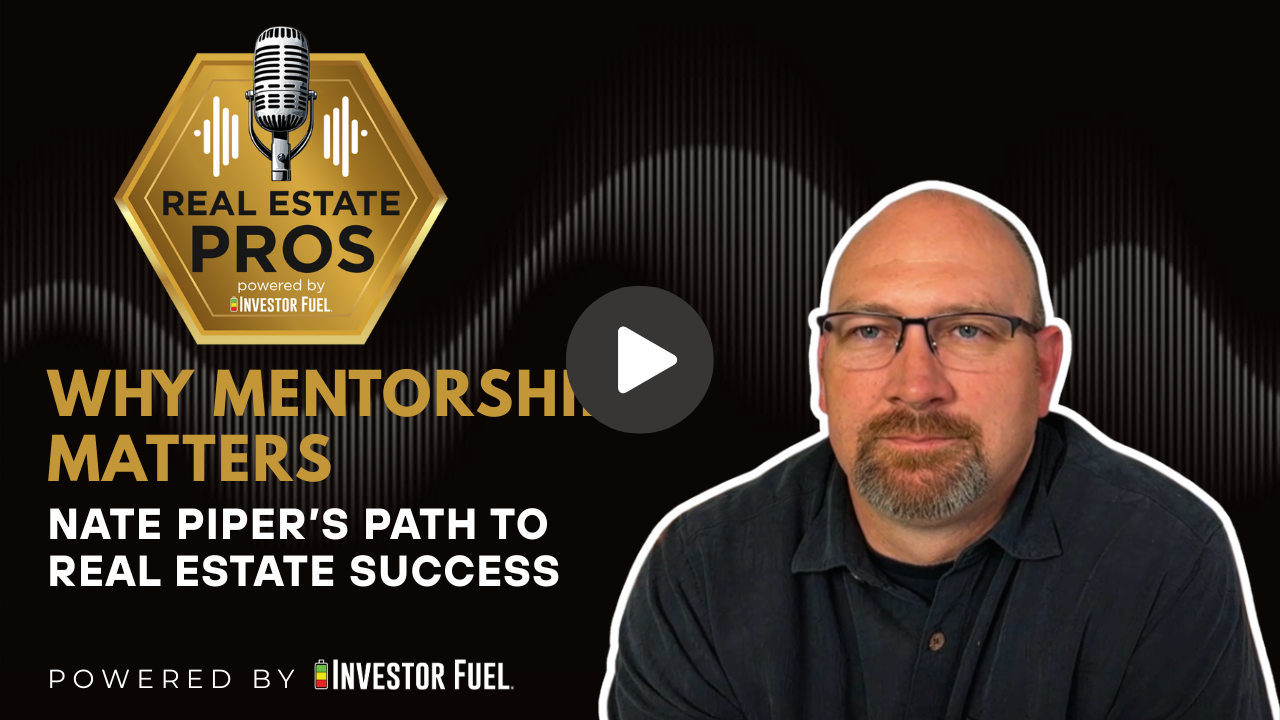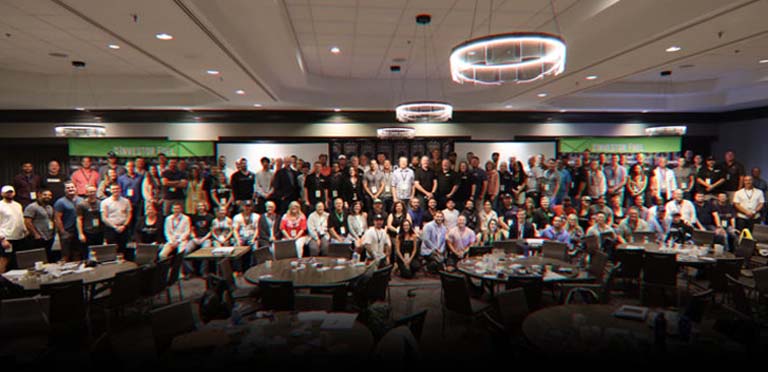<

Show Summary
In this conversation, Nate Piper shares his extensive journey in the real estate industry, detailing his transition from a construction background to becoming a successful real estate investor. He discusses the challenges faced during the 2008 financial crisis and how he adapted his strategies to rebuild his portfolio. Nate emphasizes the importance of networking, mentorship, and continuous learning in achieving success in real estate, particularly in the niche of subdivision development.
Resources and Links from this show:
Listen to the Audio Version of this Episode
Investor Fuel Show Transcript:
Dylan Silver (00:00.846)
Hey folks, welcome back to the show. I’m your host Dylan Silver and today on the show we have Nate Piper. Nate is a real estate professional with over 20 years, 35,000 projects and over 350 million processed transactions worth of experience in the greater DFW Metroplex as am I. Nate, welcome to the show.
Nate Piper (00:21.73)
Thank you.
Dylan Silver (00:24.607)
Nate, always like to start off at the top with how folks got into the real estate space. Was it in your blood?
Nate Piper (00:32.174)
Not really. mean, I guess I came in through the construction aspect or manual labor that then developed into buying and holding and doing a lot of different real estate deals.
Dylan Silver (00:46.03)
So coming from a construction background, I’ve seen a couple different paths. Most commonly, people that I’ve seen go from being a tradesman to then being a general contractor and then realizing I’m doing this for other people, let me do it for myself. Was that similar to your path or different angle?
Nate Piper (01:03.649)
Yeah, pretty much similar. I just had some different mentors. I kind of grew up with a bunch of uncles that were already tradesmen and they already had their own businesses. And so I got to see it from an early on perspective. So I just kind of fast tracked that a little bit.
Dylan Silver (01:19.832)
So coming out of high school, did you know this was going to be your career?
Nate Piper (01:23.596)
Oh no, coming out of high school, I wanted to be an NFL player and I wanted to go day one, play sports and have fun. It wasn’t until after I graduated, well, I always kind of worked in the construction industry, but it’s side jobs and summer jobs and things of that nature. then went to New York, try to be a stockbroker, found out I didn’t like the hours or the tie.
hop back into construction and then led back into real estate, buying and selling and flipping and, you know, having fun.
Dylan Silver (02:00.802)
I’m from a town 27 miles outside of Manhattan called Caldwell, New Jersey, Caldwell West Caldwell, New Jersey, which is basically, for all intents and purposes, pretty far from New York City because you have to go through, I believe it’s the Lincoln Tunnel, and it’s a hike to get in there. But I’m from that area of the woods. So how long were you in New York for?
Nate Piper (02:06.9)
Okay.
Nate Piper (02:24.395)
Yeah, I made it about seven months, six and a half. No, yeah, it was what, you know, I came from, I came from Texas and I went there. It was great. And this was back early 90s. So New York was a phenomenal place to be. It just, it just didn’t gel with me and the vibe. And, and I had a, a matchbox for a room and the bathroom was at the end of the hall. mean, it was like,
Dylan Silver (02:28.194)
You knew right away, you said this isn’t for me.
Dylan Silver (02:51.565)
I
Nate Piper (02:51.722)
100 square feet maybe I was in you know uptown New York. I was you know Get up early shower and you had to wait in line to get into a shower because all the other people on the floor were all trying to get the shower at the same time we were arguing and fighting and you know, there’s always noise and chaos and I didn’t mind all that it was just Being a stockbroker and being on the phone calling everybody and I wasn’t
I was an analyst, right? I was like a junior, junior analyst. mean, I was just allowed to make the phone calls, make the presentation and then pass it off for somebody else. So it just, I just didn’t like that career. I didn’t like wearing the tie. I didn’t like working the hours. I didn’t like the people I was working with. It just a lot of frustration. And a buddy of mine called me and said, Hey, a hurricane hit down here in Florida. I need some help. Do you mind coming down for the weekend? And I said, absolutely. And I went down there and
realized that I really loved getting my hands dirty and being a part of it. And I called up my roommate up in New York and I said, Hey, just mail me my stuff and tell the boss I quit. And that was the end of my journey for trying to be a stockbroker.
Dylan Silver (03:58.476)
Wow, wow, so many thoughts that I have. So I’ve had other stock brokers on the podcast and one of the things that I’ve heard now routinely is they go in with, in a sense, some level of rose-colored glasses because they’re thinking I get to analyze, I get to help people grow their wealth and provide feedback that they might not otherwise have. Of course, in many cases, access to the internet might have been different and so…
Then they get there and they realize they’re really just calling and in some cases I’ve heard this term like shoving these stocks down people’s throats. Was your experience any of that?
Nate Piper (04:35.525)
Yeah. That is exactly the experience. You get a call list, right? And you got to dial every number on the call list before you can leave for the day. And these people don’t even want your services. They don’t even know who you are. And what it did for me though, was that it gave me that cold call list profession where I’m not scared to go up and talk to anybody or reach out or…
Dylan Silver (04:39.704)
Ha ha.
Dylan Silver (04:58.862)
experience.
Nate Piper (05:03.292)
get rejected or any of those pieces, but it was difficult.
Dylan Silver (05:07.18)
So you get down to Florida, which town I love, Nate, I love Florida. Maybe my favorite, I’m in Denton, Texas, but maybe my favorite town in the country is Fort Lauderdale. So where in Florida were you?
Nate Piper (05:11.611)
Yeah.
Nate Piper (05:20.667)
Well, I got stationed down there in the Keys and then moved up into South Miami. So I fell all over Florida too. I’ve been all over Florida. But going from New York down to the Keys was a huge transition. It was great. It was flip flops. was perfect weather. I had to fight off a few alligators, but that’s a whole other story. But it was great. You know, it just, you know, we were working on some
Dylan Silver (05:42.723)
Ha
Nate Piper (05:46.852)
some beachfront property and just restoring it and had a lot of fun. And I was like, I just don’t want to go back to that tie.
Dylan Silver (05:53.454)
So at that point, Nate, you’re, I’m imagining 23, 24 years old, somewhere around there, and you have your buddy down there who is getting you into restoring these properties, and you’re seeing yourself doing this, you’re saying, I wanna do this. So what’s the next steps from there?
Nate Piper (06:08.326)
Yeah. Well, you know, I, I ended up just kind of opening up my own restoration business. Now my buddy, was, you know, 10, almost 14 years older than me. Um, and so he was already established. already had his restoration business, but he needed some labor and some hands. Um, and we worked together on some other projects. And so, but he kind of led me in through the investing view of like, Hey, look, um, just because, you know,
this thing’s destroyed does not mean it’s not valuable. And that’s what kind of kicked me off to a lot of my fix and flips where I was able to buy properties and look at properties at a different perspective because most people are saying that this is too much work or this is a destruction or disaster zone. I see dollar bills and cha-ching, cha-ching and how I can make it work and make it better and make it reusable. And it got me into a lot of the sustainability processes of being able to like, how do I take something old?
refresh it, and make it usable again.
Dylan Silver (07:09.27)
Man, Nate, I’m imagining myself in your shoes. I don’t think you could have taken me out of the Keys. I think I would have just stayed there and I would have, although I love Texas, I would have said I’ll come visit my friends, but God bless, what a gorgeous area the country is as long as there’s no hurricanes down there. So you’re down there, you have your own restoration business. Talk about the first deals that you were doing on your own. How did you find these deals? You have a new company, you’re a business owner.
out of school, tried one career, realized it wasn’t a fit for you, had this other career that you like, and are opening up a business for yourself.
Nate Piper (07:47.672)
Well, so first off, I’m a serial entrepreneur and have been since I was about 10. And so it’s like, okay, I came down there to help out my buddy, but then I’m going to dinner. meeting with insurance adjusters and finding out what they’re doing down there and start networking. And then I realized, well, if I could get this under contract, I could sell that contract. That was my initial piece. So then I was like, okay, I can work during the day.
and do manual labor and have fun and then go to dinner and meet a bunch of people and then try to start figuring out, okay, I could sell this paper because I understood from being, you know, just in the business world of having successful parents that like not all thing has to be cut and dry. And so I can do multiple things at the same time. So I was like, well, if I could get this paper under contract, I can sell that to somebody else and take some money.
So that was kind of my wholesaling, bird dogging kind of experience where I was just like, Hey, let me take this property where I’m working next door to it. And I know that it’s distressed, but I know I can get it at a discounted price and then sell it to somebody else who’s going to be able to restore it. So that was kind of my launch.
Dylan Silver (09:03.214)
So you were doing wholesaling. Where did you learn about assigning contracts? Down there.
Nate Piper (09:09.791)
You know, it really came as an idea as I was sitting at a dinner table with a public adjuster and I said, Hey, you know, how would I sell off this property to somebody else? And he was like, well, you need to fill out this contract. You need to put it right here as a side as, and then you need to get a title company. And so it took me on my path to try to like figure this thing out. This was, this was early 2000. So, there wasn’t a lot of information out there. I think.
there’s a handful of Googroo’s that were selling programs via DVD and maybe even cassette tapes, but I didn’t buy any of those. I just kind of heard about them. And so I was just trying to figure this out on my own. And I just had a good mentor that I’d made friends with that kind of showed me a contract. And then I used that same contract for like four years and took down probably around 60 projects or 60 properties during that time period. And I just rinsed and repeated it.
Dylan Silver (10:06.894)
That first deal Nate, what was the process like for acquiring that? Where did you find that lead?
Nate Piper (10:16.222)
Yeah, it was, it was literally next door to a house that we were remodeling and the customer, you know, I went over there to sell them a remodel, right? And I was like, their house is all destroyed. And I was like, we can, we can fix it up for you. We can make it all nice and new and all this. And she was like, I just want to get out. I want to leave. And that’s when the light bulb went off. Like, well, if she wants to leave, I know that information. The other guys don’t know that information. So I said, well, how would I buy it from you?
And she was like, you want to buy this house? I’ll sell it you super cheap. And I was like, I heard cheap and I heard you want to buy it. So I got to figure it out. So I went back and I figured out, you know, how to get the contract. And I went back over to her and this was back way early on. So I think I bought it for like 80, $88,000 small little house right on the beach. I turned around. I mean, it was just basically a shell. Everything on the inside had to be gutted.
But you know, that property is probably worth, you know, $3 million today. yeah. And I picked it up for like 80 and I remember I only put a hundred dollars down to title and I, I flipped the paper and I gave, I sold it over to the guy who was trying to help me. anyways, I made 10 grand on the project that day. Took me less than, you know, four hours involved in making the deal happen and going to title company. got a big old check.
Dylan Silver (11:17.321)
my gosh.
Nate Piper (11:42.332)
It was more than what I had made that week working. And I was like, well, I can do this and I can do that. So I was doing both things at the same time, but it was an eye-opener for me.
Dylan Silver (11:52.472)
So from there it’s like proof of concept. You see this works, you say, okay, wow, this is totally new. I’m revitalizing these homes, but this was something totally different. How much of your time from there on out was spent actively looking for those type of leads? Or was it more you were doing this other work and you would, time to time, stumble upon these opportunities and you were ready to seize them?
Nate Piper (12:16.763)
Yeah. Yeah. It wasn’t a full-time job for me. A full-time job was doing what I was enjoying doing, which was creating and building and, and restoring. That was what I was passionate about, but this was just extra side cash that kept coming in that would float other projects or was able to help me expand into my construction business. And so, as they kind of came up, I would just take them down and it would
I wouldn’t spend maybe two hours a week. I might knock on some doors. might look around. I might ask somebody or it come up in conversation. Do you know anybody selling a property here locally? Because I ended up going and storm chasing for five years. And so I was bouncing around to all of these different areas. And I just rinse and repeat that same conversation. Um, and that’s kind of what put me on what I was doing. I got up to a point where I had about 35 properties and then 2008 hit.
And that was a whole other story, but you know, it was a good, it was a good run.
Dylan Silver (13:19.982)
Okay, organic growth with wholesaling, continuing to do revitalizing, you have your own personal portfolio. At this point in time, sounds like maybe mid to late 20s. Mid to late 20s. and early 2000s?
Nate Piper (13:36.71)
Yeah, early 2000s, like 2001 all the way up through 2008 was up until this.
Dylan Silver (13:41.654)
I can only imagine you must be feeling like a million dollars. Like you must be feeling like I’m in the Keys, I’m young, I have my company, I have a real estate strategy that I don’t see a whole lot of people doing, and basically this is great. And then 2008 hits. And so what was that like for you?
Nate Piper (14:00.88)
Yeah.
Nate Piper (14:05.443)
stressful. 2008 was a weird time. It’s like you had more property, I had more properties than what I could afford, right? And I had tenants that weren’t paying. So I had to like start making some decisions and nobody wanted to buy anything that I was selling. I had a few of them kind of go into foreclosure. I ended up, you know, finding a guy out of Austin, Texas. His name was
It starts with a C. I’ll think about it in a minute. But anyways, I found a guy, he was specializing in helping investors, you know, reevaluate their portfolios and helping them with the banks to kind of get back into good graces. And Sharpen, Sharpen, Alex Sharpen is his name. And great guy, had a lot of knowledge and I just kind of followed his process and I ended up.
surrendering over most of their properties. I kept a couple, but I surrendered most of them back over to the bank. You know, took losses, but you know, those were the lessons that I had to learn at that point in time.
Dylan Silver (15:14.306)
Wow. So I can only imagine this had to hurt, as it does for all the real estate investors that I talk at this point in time. You go from the high of the high to now feeling like, wow, this is a huge burden, how do I get myself out from underneath this? So with that, you’re still young. Like you’ve done all of this while still being young. People could do all of this, and I have had many people talk about this with families and so on and so forth. So in a sense,
Nate Piper (15:29.751)
Yeah.
Dylan Silver (15:42.68)
probably grateful that that happened when it did happen. From there, do you stay in Florida? Do you regroup and stay? Okay.
Nate Piper (15:49.023)
No, at that point I’d already moved back to Dallas. I already moved back to Dallas. I already started having some kids and married and living life back here. I traveled around through Florida, most of the Southwest, Southeast, everything from Arizona all the way over through Florida. So I just kind of bounced around. I had opened up offices for my restoration and remodeling company in like seven different cities.
and was running it out of Dallas and then 2008 hit and it started to slow down not only the restoration pieces, but the remodeling, new home construction. And then I had also all my rental properties. And so I was dealing with trying to juggle through a lot of that all at the same time.
Dylan Silver (16:34.264)
Wow, okay, so throw family in the loop, throw multiple companies in the loop. What’s the next couple of years look like? So 2010, 2011, 2012, things are improving, you’re back in Texas. Do you start the process over again or are you way more cautious this time and pivot a bit?
Nate Piper (16:53.537)
You know, I got out of buying real estate for about five years. So I stayed out of purchases. I focused more on the restoration business because the restoration business was a recession proof business. I would get a bunch of my phone calls and projects coming in through the insurance companies and through, you know, different companies that I made relationships with that were self-insured and
process most of those projects through there. That’s what kept me alive and kept me afloat was that I had something else other than just, you know, real estate that I was focusing on. I got together with a bunch of real estate investors and kind of became an expert for them and coached them through the purchasing because around that time we moved into, so 2008, the start of the crash, 2009 was really hard, 2010, nobody was buying anything.
2011 real estate groups were starting to bring out the, um, the bank owned properties and starting to do short sales. And during that process, um, they were looking at evaluation of like, what’s wrong with all these projects, what’s wrong with all these apartment complexes. Um, and they’d been in dis dis array and haven’t been had any maintenance done for years at that point. So, um, I ended up contracting with a bunch of real estate investment groups and going out and doing evaluations.
Dylan Silver (17:59.214)
Mm-hmm.
Nate Piper (18:23.061)
And on some of them, got a percentage of the deal. get a small, a small portion, uh, just to kind of help navigate their, their buy. And then I get paid on the backend when they sold in five years. So I was doing that, um, most of 2010 and 11 and 12, 2013, I got back into buying and holding. Um, that’s when you can still buy something at a reasonable price here in Dallas. Anyway, uh, you can still find a three bedroom, bath for under 200,000.
Dylan Silver (18:34.466)
Okay.
Nate Piper (18:52.18)
Now you can’t do that. But, and it was great. And I held on a bunch of those properties until 2019 and then sold those off for some substantial cash and kind of kept going.
Dylan Silver (18:52.942)
I
Dylan Silver (19:03.822)
So that gives us a lot of context there. You experienced a rebuild. You’ve now done it twice. You have to feel at this point bulletproof, and it’s in a way because you said, okay, I saw the worst of the worst effectively in Florida. Everyone was, you know, blood in the waters type of deal. I’ve now rebuilt it back again. Fast forward to today. Bring us up to speed to today. 2025, what’s business like today?
Nate Piper (19:32.721)
Well, I still have my restoration business. I still have my remodeling business. I still have ground up building. You know, I’ve got some other certifications and classifications that I can kind of go and do things, but I’ve moved into doing BTR stuff and doing ground up development. Those are the things that I like doing the best.
Dylan Silver (19:54.914)
So that’s new builds, effectively.
Nate Piper (19:57.714)
Yeah. You know, I like new bills. They’re quicker. They’re faster. They’re easier for me. Right. I have a construction background, understand construction science to the fullest. So for me, picking out the land, being able to do the development, put in all the utilities, do all the, do all the grunt work that nobody else likes to do. Most, most investors like to do the pretties. Right. Then you’ve got a small percentage of investors that like to do the uglies. Right.
Dylan Silver (20:17.827)
Yeah.
Nate Piper (20:26.0)
You know, dirt work is one of those ugly things that you got to do it right. You got to know what you’re doing. Nobody wants to do that portion of it. They just want to buy the lot after the dirt work’s been done, after the zoning has been done, after all those pieces. But those are the things that I like doing.
Dylan Silver (20:42.432)
Okay, so this is a totally new subject to me. I’m not in any way someone who has any exposure to this. I’ve on some level participated in demo work on fix and flips, but that’s it. And I’ve seen where things can go wrong. I was actually at a flip in Denton where we took up the subfloor and there was a crack in the foundation. Somehow this was made worse with plumbing work and they needed to foam the floor. So was the first time that I’d seen this, but I was also able to see
how once you start looking at these things, it quickly escalates from there, depending on what happens. So when you talk about groundwork, what are some of the complications that come up if there are any, and what is it about it that is perhaps unappealing to the average investor?
Nate Piper (21:18.075)
Sure.
Nate Piper (21:32.493)
Well, they start getting into more scientific issues, right? Like soil testing, knowing what soil is there. Was it on a riverbed? Was it a loose soil, stable soil? Are you building on rock, right? All these things have things to do with when you’re starting to put in roads and you’re starting to put in utilities and undergrounds, right? So understanding how you’re going to build out
a 40, 60, 100 acre subdivision and understanding where those streets are going to go, where the river water runoff is going to be, where the utility lines are going to come and how everything’s going be plumbed in. It’s not pretty, right? It’s more analytical. It’s more kind of science-based to be able to kind of make sure that you’re putting things in the right perspectives. So if not, if you do it wrong and you have water runoff and you flood out a house,
the developer is at fault, not the house, right? So you wanna make sure that you have retention pods, retaining walls, all your structures kinda set up so that you can do it appropriately.
Dylan Silver (22:32.279)
Mmm.
Dylan Silver (22:43.096)
So in building out subdivisions, I’m imagining, you know, there’s kind of a, probably a handful of people who can do this, but once you do one, it becomes significantly easier to do rinse and repeat because people see, okay, this person built out that subdivision, let’s bring them onto this project. So was that, was that effectively what you saw in your growth? You had a subdivision, this became the one that you built out initially, and then you had organic growth from there.
Nate Piper (23:10.766)
Kind of. kind of take it back. One of the things that I kind of created was trying to work with home builders, right? And so one of things that I did was I warranty service repairs for home builders underneath my construction company. So when I was doing that, I got to work with 20 to 25 of the top home builders in the country and their subdivisions and learned how they laid them out, learned how they did it.
I got involved in planning, got involved in helping them develop the plans. And from there, I grew and gained the knowledge that I needed to be able to step out on my own and do it myself. So it wasn’t like I just jumped into it, you know, just off the end of the pool. you know, I kind of learned and watched and paid attention to contribute. Exactly. Exactly.
Dylan Silver (23:52.973)
Okay.
Dylan Silver (24:02.294)
an apprenticeship of a kind. So for folks who are wanting to get into this space, it’s a niche space, right? Building out subdivisions. I’ve always said this to people, if you want to be in real estate, you have to have two skills. And I’ve said this on earlier podcasts. You’ve got to have a kind of entrepreneurial neuroplasticity, if you will. You have to be able to change. You have to be able to adapt your lifestyle day to day.
Nate Piper (24:28.823)
Sure. Yeah.
Dylan Silver (24:30.23)
And you’ve also have to be like, guerrilla networking. Like it is, it’s too much for a lot of people. It’s a lot. Put yourself out there all of the time. And I had a guy who was a stockbroker who ended up becoming a capital raiser in the commercial real estate space. Tell me, look, if you want to raise money, you just got to tell everybody what you’re doing. I’m like, everybody? And he’s like, everybody. And I was like, well, I don’t know that that could frustrate them. He’s like, do you want to raise money or not?
Nate Piper (24:37.568)
Yeah. Yeah.
Nate Piper (24:53.558)
Yeah.
Dylan Silver (24:58.006)
And I was like, wow, and this is a guy on podcast, know? So I heard that and I was like, okay, I have to actually think about things differently. And so hearing your story, it parallels that because you’ve had your business grow and scale in a way that really wouldn’t be possible if you weren’t seeking out these different opportunities for education for, hey, how do I build out a subdivision? And then from there, getting multiple.
Nate Piper (24:59.68)
Yeah.
Nate Piper (25:19.69)
Yeah.
Nate Piper (25:23.627)
Yeah, I agree with the other guests, right? You have to be tenacious. You always have to be going out there and learning and kind of putting it out there. never been one of those guys that just put all my eggs in one basket and that’s my only source of income. I get it. A lot of real estate investors, they wanna leave their W-2 job to then transition over into just being full-time investors.
I’ve just seen too many of them fail because they don’t have anything else going on or they’re not branching out or they’re just staying in the same pond instead of getting into a different pond or getting to a river or getting into an ocean. And they learn from the same people all the time instead of expanding out. I diligently try to kind of like find different groups of people that I’ve never been in and step into those rooms and have intentional conversations. And I think that’s important.
for any aspect of business, right? Because no matter if you’re a real estate investor, a construction worker, an IT person, a stockbroker, it doesn’t matter. You have to step into different rooms and talk with different people because you’ll gain different conversations and you’ll have different insights to what’s going on.
Dylan Silver (26:42.934)
Yeah, Nate, to your point, those strategic relationships, you have to be intentional about it. They’re truly not going to fall on your lap. I’ve had to pay to get in some of these rooms, and I’m glad that I did. And at the time, it seemed like, wow, this is new concept to me. But if I didn’t do that, I would not be sitting here. I would not have gotten into real estate wholesale, would not have gotten a real estate license. I would have still been selling cars working for Nissan. That’s just the truth.
But Nate, we are coming up on time here. Where can folks go to get a hold of you?
Nate Piper (27:14.482)
Sure. If you want, look me up through my restoration and construction companies, GRSPROS.com, GRSPros. You can find that on all the social media handles. It’s probably the quickest, easiest way to get a hold of me or get a hold of my team and they’ll get a hold of me. And you know, I’m here to help. My whole mission in life now is kind of, you know, looking at giving back.
trying to help and raise young entrepreneurs and just kind of be a guide.
Dylan Silver (27:50.794)
Amen to that. Nate, thank you so much for your time. Thanks for giving value to our listeners. And thanks for coming on.
Nate Piper (27:59.559)
Thank you.






